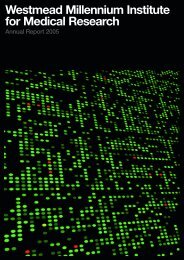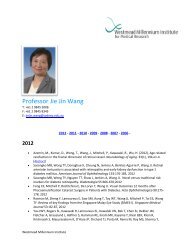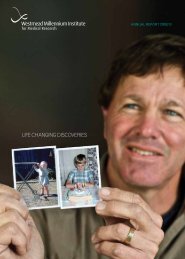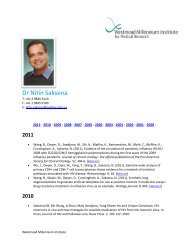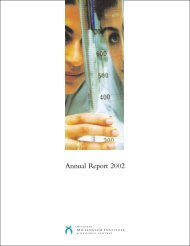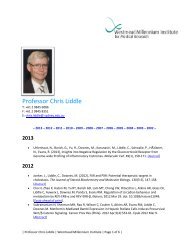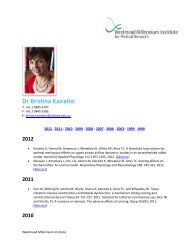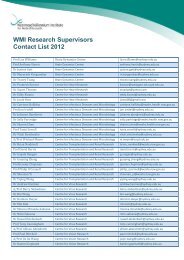Translating >> - Westmead Millennium Institute
Translating >> - Westmead Millennium Institute
Translating >> - Westmead Millennium Institute
Create successful ePaper yourself
Turn your PDF publications into a flip-book with our unique Google optimized e-Paper software.
12 13 > Overview // AR 2006<br />
The positive benefits lasted only a few years, and the<br />
centre is now leading a larger Australian consortium, with<br />
substantially increased Federal Government funding, which<br />
is being administered by the Juvenile Diabetes Research<br />
Foundation. The aim is to examine anti-rejection treatments<br />
that may reduce the risk of islet cell grafts failing. The<br />
researchers hope to develop safer and more effective processes<br />
for islet transplantation and to have a better understanding of<br />
what happens to the graft after it has been transplanted.<br />
Dovetailing this field of research is the centre’s pioneering<br />
work aimed at creating a limitless supply of insulin producing<br />
cells using modified pigs as the source. In collaboration with<br />
a numbers other researcher groups the centre is investigating<br />
ways to design pancreatic islet cells that can be taken from<br />
pigs that will be more resistant to the human immune system.<br />
The Centre for Virus Research is a world leader in research<br />
on human immunodeficiency virus (HIV) and the herpes<br />
group of viruses including herpes simplex virus (HSV),<br />
cytomegalovirus (CMV), and Varicella Zoster virus. The<br />
Centre’s main focus is to identify how these viruses infect<br />
patients to develop ways to diagnose, treat or prevent them and<br />
their transmission in the international and local community.<br />
In 2006 an estimated 40 million people were infected with<br />
HIV worldwide. The centre has helped identify how HIV<br />
infects patients via host cells called dendritic cells, which are<br />
found in the lining of the genital tract. In women, this lining<br />
is thinner and less protected than in men. Understanding<br />
how these early interactions occur is encouraging the<br />
development of ‘microbicides’ or decoys, which may stop<br />
the virus from entering cells of the genital tract. The Centre<br />
is now collaborating with a biotechnology firm to develop<br />
novel candidate microbcides.<br />
Centre researchers are also using sophisticated techniques<br />
to study how HIV induces changes in hundreds of human<br />
genes that simultaneously occur within a single infected<br />
dendritic cell. Other important work is directed at how a<br />
group of people infected with a weaker strain of HIV have<br />
been able to naturally control it. Recently, this work has<br />
led to the discovery of defensive proteins, which appear to<br />
control HIV in these patients.<br />
Cytomegalovirus affects about 60 per cent of the population.<br />
It is usually controlled in healthy people, but can be fatal<br />
in immunosuppressed people such as those who have<br />
undergone bone marrow or solid organ transplants.<br />
Researchers have been defining the mechanisms that keep<br />
CMV dormant and the chemical interactions that trigger its<br />
activation. This work has led to the discovery and patent of a<br />
type of interleukin-10, a protein that inhibits key functions<br />
of immune cells.<br />
Shingles is a painful condition affecting many elderly<br />
individuals caused by re-emergence of dormant Varicella<br />
virus years after causing chicken-pox. An exciting research<br />
project is underway that may provide insight into the<br />
molecular immune processes which allow this and then<br />
control the re-emergence. With ethics permission, autopsy<br />
material from patients who have passed away at the time of<br />
a shingles episode are being used to identify such immune<br />
mechanisms in the hope of improving the success rate of<br />
current vaccine (about 60 per cent).<br />
The centre has already pioneered work showing how herpes<br />
simplex virus travels in nerves between the site of infection<br />
on the skin and the site of dormant infection near the spinal<br />
cord. When the virus is activated, it travels back to the skin<br />
surface to present as cold sores or genital herpes. The Centre<br />
is unraveling mechanisms that trigger this viral activity to<br />
produce blocks that may stop the outbreaks. Negotiations<br />
with a US biotechnology firm are underway to fund this<br />
research in return for licensing one of the centre’s patents.<br />
Research into HSV type 2 is significant because it causes<br />
genital herpes and enhances HIV by up to three times. The<br />
vaccine Simplirix, which was developed some years ago<br />
based on discoveries made by the centre, is being retrialled<br />
in the US with availability forecast within about three years.<br />
Simplirix has shown to be about 75 per cent effective against<br />
genital herpes infection in women who have never previously<br />
had HSV. Centre researchers are examining how immune<br />
processes control virus infection in an attempt to improve the<br />
vaccine to protect previously infected women and also men.<br />
In particular, work on how immunity to HSV type 1 (which<br />
usually causes cold sores) can control HSV type 2 is about to<br />
be patented.<br />
The <strong>Institute</strong> of Dental Research investigates the causes<br />
of major oral diseases to design new and better treatment<br />
options for patients. As both tooth decay and chronic gum<br />
infection (periodontal disease) are major health burdens for<br />
Australian communities, the <strong>Institute</strong>’s work is critical.<br />
Ongoing research into the microbiology of progressive tooth<br />
decay has identified a particular group of bacteria that attack<br />
the tooth nerve in the final stages of decay. Researchers are<br />
currently investigating new diagnostic methods that can be<br />
used in the dental surgery to predict the invasion by these<br />
bacteria, so that more conservative approaches to treatment<br />
may be applied. For the patient this may mean retaining<br />
the living tooth rather than undergoing more complex and<br />
invasive therapies, which often leave the tooth susceptible to<br />
fracture leading to even more complicated treatments at a<br />
later stage.<br />
The <strong>Institute</strong> is also developing a new anti-bacterial<br />
compound that may be able to target specific diseases or<br />
bacteria in the mouth and gums so that protective bacterial<br />
flora (good bacteria) are not destroyed during treatment.<br />
Current therapies still rely on broad-spectrum antiseptics or<br />
antibiotics, which wipe out good and bad bacteria present<br />
in the mouth. While tests are at an early stage, the eventual<br />
outcome may see low-cost treatments such as toothpastes or<br />
mouthwashes containing the specific anti-bacterial available<br />
in supermarkets.<br />
The <strong>Institute</strong> for Immunology and Allergy Research<br />
investigates diseases caused by abnormal functioning of the<br />
immune system. This includes many major unsolved diseases<br />
that plague communities worldwide. The <strong>Institute</strong>’s research<br />
programs focus on three main themes: autoimmune disease<br />
such as multiple sclerosis (MS); allergy disorders such as<br />
eczema and asthma, and why individuals vary so much in<br />
their response to infection with HIV and hepatitis C viruses.<br />
Collaborative research on the genetics of severe eczema and<br />
asthma in children has led to the discovery of a link between<br />
these diseases and several genes that are important for normal<br />
immune function called TIM-1, TIM-3 and PHF11.<br />
Researchers know TIM-1 and TIM-3 are expressed on the<br />
surface of specific types of immune cells and relay messages<br />
inside the cell, leading to cell activation through the turning<br />
on or off of specific genes. The <strong>Institute</strong> has now made<br />
important advances in understanding how PHF11 operates,<br />
showing that it is present deep inside a cell and directly<br />
controls the switching of genes on or off. Researchers are<br />
now investigating whether these genes interact to influence<br />
susceptibility to disease. Although still at an early stage,<br />
this research may guide the development of new drugs and<br />
topical therapies.<br />
Major research is also being conducted on a gene crucial to<br />
the immune system’s healthy functioning called Interleukin<br />
7 receptor alpha chain or CD127. In 2003, the <strong>Institute</strong> was<br />
the first to publish findings that a genetic variant of CD127 is<br />
important in the development of MS. The researchers believe<br />
this is due to its role in generating regulatory T cells, which<br />
stop the immune system from attacking the body’s own<br />
tissue and have submitted at patent application for improved<br />
therapy based on this discovery. Three international research<br />
groups have recently confirmed this discovery making<br />
CD127 only the second clearly established genetic risk factor<br />
in MS after HLA (a cell’s identification markers). As a result,<br />
CD127 has become one of the hottest areas of research into<br />
MS strengthened by the potential to design treatments to alter<br />
the abnormalities found in the gene’s function.<br />
In other research, the <strong>Institute</strong> was awarded an Australian<br />
Research Council Linkage Project grant to collaborate with<br />
the pharmaceutical company Biogen IDEC to investigate<br />
why up to one-third of MS patients fail to benefit from<br />
interferon, the disease’s main treatment therapy.<br />
NHMRC grant funding is also supporting research between<br />
the <strong>Institute</strong> and the Storr Liver Unit to investigate the<br />
genetics of hepatitis C. About 35 per cent of individuals fully<br />
recover from the hepatitis C infection due to their immune<br />
system clearing the virus from their body. The remaining<br />
65 per cent of patients fail to clear the virus and may go<br />
on to form cirrhosis and liver cancer. Based on these data,<br />
researchers are examining the factors in patients’ genetic<br />
makeup that determine disease outcomes when infected by<br />
the virus.



